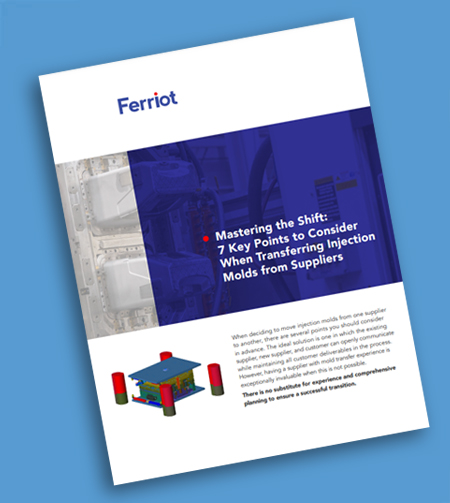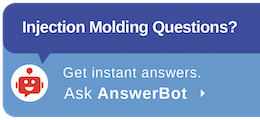Truth be told, although Ferriot has been around for close to a century accumulating an unlimited wealth of experience and applied expertise, we’ve really only been blogging for a short time. However, since 2020 marks the start of a new decade, we felt it was apropos to share our TOP 10 injection molding blog posts. The front-runners are determined by you, our frequent readers, after nearly 20,000 views of dozens of blog articles on a variety of topics. The majority of these articles are a quick read, requiring only a few minutes to consume. No doubt you’ll find them quite valuable. You be the judge…

- Guidelines for the Design and Injection Molding of Electroplated Plastics
Decorative metallic coatings allow plastic parts to function as lightweight, economical alternatives to metals in a variety of applications (i.e. automotive, appliance, business machines, etc.). One such process is electroplating, which provides a high-quality, durable finish to plastic. Today, plating grades of ABS and PC ABS meet the stringent performance requirements of automotive and appliance applications.
This article focuses on two important front end processes, plastic part design and injection molding specifically for electroplating. Both significantly influence the success when plating a plastic part.
- 6 Ways An Injection Molding Company Can Improve Your Time To Market
Keeping a competitive edge in today’s market requires speed and agility when launching new products. Time to market for new products has become further and further compressed. Early engagement with a full service plastics partner can steam-line your development process and accelerate your time to market. Here are six ways a full-service plastics partner can help your business reduce time to market for new products.
- 7 Aspects to Identify When Designing Injection Molded Parts
Are you looking to design, develop, or produce a component that needs to be injection molded to complete the project? Do you know what key aspects you need to identify as you go to design molded plastics? When going into this process, you need to identify both the obvious and not so obvious! Below are 7 items for you to consider before launching your project.
- Understanding EMI / RFI Shielding for Injection Molded Components
Today, so many different parts are being injection molded. These parts include laptop and mobile phone cases, medical and military electronic components, and a variety of other materials across industrial, consumer and specialty markets. Because of this, EMI and RFI shielding is becoming increasingly important. Proper shielding for injection molded component parts is necessary to meet regulatory requirements as well as ensure continued, reliable performance.
- How to Ensure Injection Molding Success with Proper Screw Choice
There are many variables that impact the success of injection molding a good part. One of these variables is injection machine screw choice. When it comes to screw choice, choosing the right screw geometry for your project is crucial to success. It will ensure there is no material degradation and that the material will have been properly melted. This will result in less stress in the part, less scrap, and proper size and weight.
- 9 Benefits of Metal-to-Plastic Replacement
In today’s world of manufacturing and new product development, the need for fast-paced production and the existence of complex designs is greater than ever. Historically, manufacturers have depended on metal due to an existing wealth of metal knowledge, it’s strength and stiffness, perceived quality, and ideal properties related to electricity, UV performance, and chemical resistance. However, due to a fluctuating economy, high cost of goods, and smaller margins, the need for materials that can reduce weight, cost, and production time is huge.
- 2 Reasons Why You Should Paint Plastic Molded Parts
Painting plastics is not easy, as special paints are required to give your parts the desired finish and ensure it bonds well with the plastic. However, painting techniques have evolved over the years and there are several different means by which the plastic parts can be painted to meet any need. There are two main reasons why plastic parts should be painted: appearance and functionality…
- Types of Resins Used in Injection Molding
When beginning the process of developing a plastic component through the injection molding process, one of the top priorities needs to be identifying the type or types of resin to be used on the product. While there is opportunity to customize the resins to fit the end use of the part, there are a wide variety of resins available, which opens up unlimited possibilities in design and function.
The first step in the process is to identify the key physical attributes that the end product requires. Below is a list of properties the need to be evaluated…
- 5 Reasons Why Polypropylene Siding Is Better Than Vinyl Siding
When I initially joined the building products industry in 1999 there were 30+ manufacturers of vinyl siding. Fast forward to today, and it’s now down to 9, mostly through consolidation. It remains the #1 choice for exterior cladding across the US, primarily due to its low cost and maintenance freedom. And it looks EXACTLY like it did in 1999. Nothing has changed. People have been driven to this product over the years because it was the closest thing to resemble wood, without having to paint it, stain it, or maintain it.
GOOD NEWS! You have an alternative… Injection Molded Polypropylene Siding, and here are 5 reasons why it’s better than vinyl…
- 3 Common Pad Printing Problems and How to Troubleshoot Them
Pad printing is an innovative and effective process for transferring a two-dimensional image onto a three-dimensional surface. It can also be a delicate process with numerous variables that can lead to an unsatisfactory image transfer if done incorrectly. My goal in this post, assuming the reader has a basic understanding of the pad printing process, is to touch on a few of the more frequently encountered problems that cause poor image transfer and how to troubleshoot them.
In my experience with pad printing, the three most commonly encountered problems that arise while printing on a job are as follows: an incomplete print or a print featuring excessive voids, distorted and blurred prints, and the pad carrying excess ink or dirt outside of the desired image.
We’re just getting started…
Of course, we’ve only scratched the surface when it comes to addressing the countless questions, challenges and problems you’re facing in order to complete your injection molding projects on-time, within budget, and without sacrificing quality.
Do you have a question you’d like answered but are afraid to ask? Feel free to use the form below or Contact Us and we’ll be glad to get back to you. We may even feature the answer to your question in a future blog article or FAQ resource.
All of us at Ferriot wish you a happy and successful 2020!
Subscribe to the Ferriot “Plastics & Injection Molding Manufacturer” blog.




